Original Tour

The Original Tour Route starts here from Dublin Bus Head Office, 59 Upper O'Connell Street. Across the road is the spire designed by British architect Ian Richie. This is Dublin’s tallest landmark and stands 120 metres (390 feet) tall. O'Connell Street is the main street in Dublin city and was the scene of much of the fighting in the 1916 Easter Rising.

This is the starting point for the Docklands Tour Route. The Dublin City Gallery (Formerly known as the Hugh Lane Gallery) is a public gallery with free admission for all. The gallery is open Tuesday to Thursday 9:45am– 6pm, Friday 9:45am–5pm, Saturday 10am–5pm and Sunday 11am–5pm. The Dublin Writer’s Museum first opened its doors in 1991 and displays some of Dublin’s finest literary works. The museum is open Mon-Fri: 9.45a.m.-4.45p.m. and Sunday 11a.m.-4.30p.m. Across the road the Garden of Rememberance is a memorial to those who gave their lives in the cause of Irish freedom, designed by Dáithi Hanly with a central sculpture depicting the Children of Lír by Oisín Kelly, Queen Elizabeth II laid a wreath in the gardens during her state visit to Dublin in 2011. Close to Parnell Square is 14 Henrietta Street - a stunning attraction which depicts life in tenement Dublin.
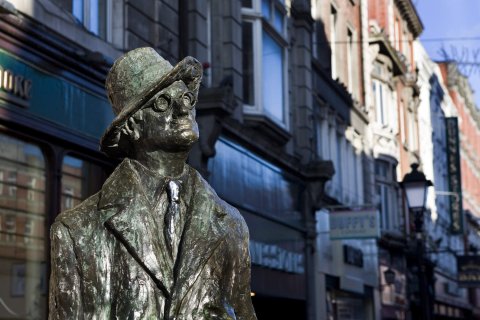
Here you can see the statue of Daniel O’Connell, who gained Catholic Emancipation for Ireland in 1829 and managed to overthrow the penal laws which denied many rights for Catholics in Ireland. The statue is made of bronze figures with a granite plinth. It stands 40 feet tall and has four angels at it's base which were crafted to represent a virtue most readily associated with Daniel O'Connell, namely patriotism, courage, eloquence and fidelity. It is said that each one also represents the provinces of Ireland, Leinster, Munster, Ulster and Connaught.
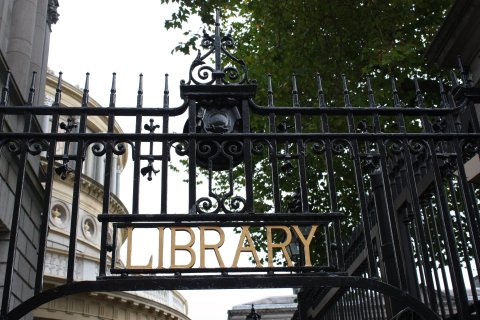
Take a visit to the National Library and Museum, or the wonderful Archeology Museum, both of which are open freely to the public. Opening times; Tuesday - Saturday: 10am-5pm Sunday and Monday: 1pm-5pm Closed Christmas Day and Good Friday - Highly recommended!
Also from this stop visit one of Dublin’s most iconic shopping districts, Grafton Street, a short walk away. Take a walk down this glamorous street and don’t be surprised to see large crowds gather to watch buskers such as poets, musicians and mimes! Take a walk also to nearby Suffolk Street to see the famous statue of Molly Malone.
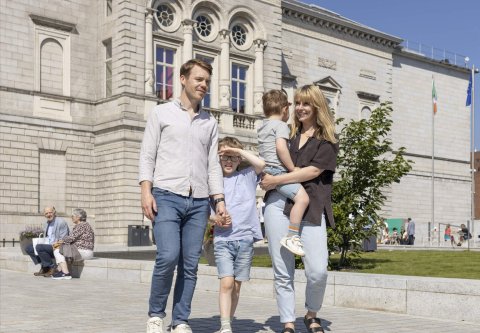
One of the must see attractions when visiting Dublin is the world renowned National Gallery of Ireland. The National Gallery opened its doors in 1854 and 163 years on it continues to inspire and delight visitors to the capital.
Located on Merrion Square West, the Gallery is an art lovers dream with over 2,500 painting and approximately 10,000 other works including some awe inspiring water colours and sculptures. The collection includes works from famous Irish artists such as Daniel Maclise, Roderic O’Connor, John Lavery and Jack B. Yeats. The Gallery has a distinctly international feel with works from renowned International artists like Monet, J.M.W. Turner and Pablo Picasso. This collection, which spans the history of western European art, also includes Caravaggio’s breathtaking ‘The taking of Christ’. It truly has a collection to rival any gallery in the world.
It is also a great place for all the family with a dedicated children’s audio guide, free workshops for Children and holiday course children and young teens! Visitors can also enjoy a cup of coffee and a bite to eat in the beautiful Wintergarden Café.
And you know what the best bit is? It’s all free! Yes that’s right, you can check out all the tours, workshops, lectures and concerts for free!
You can check out the Gallery’s ‘What’s On’ calendar for information on upcoming events or follow the National Gallery of Ireland through Facebook, Twitter and Instagram.
Here you can visit the National Gallery which is home to some of the world’s finest art. Open 9.15a.m.-5.30p.m. Monday to Saturday (open late Thursday until 8.30) and also open 11.00am to 5.30pm on Sundays. Visit their website and plan your visit today.
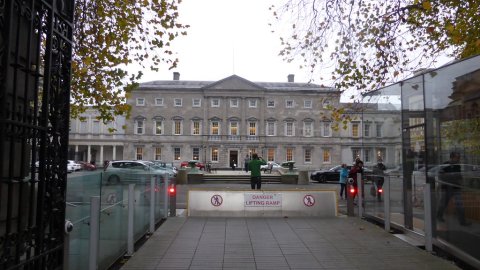
Leinster House the location of the Dáil (Irish House of Parliament) is well worth a visit. It was opened in 1748 as the ducal place of the Duke of Leinster but since 1922 it has served as parliament for the Irish Free State. Directly beside Leinster House you will find a real hidden treasure; The Natural History Museum (known by Dubliner's as the Dead Zoo). Admission to the Natural History Museum is free. Plan your visit here.
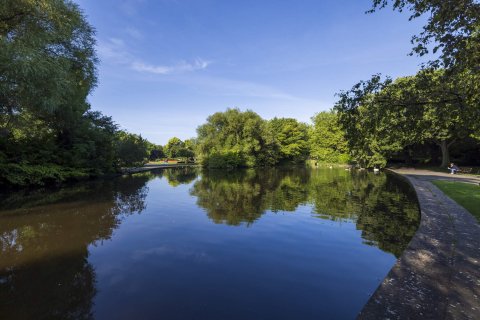
St. Stephen's Green is a city centre public park that dates back to 1664. Considered by many to be the very heart of Dublin city, it is a short walking distance to Dublin's premier shopping street Grafton Street. The wonderful Museum of Literature Ireland (MoLI) is situated on the south side of the square. The Green itself was designed for the local residents that resided in the nearby Georgian townhouses but was opened to the public in 1880. The park was one of the key locations taken over by the rebels during the 1916 Easter Rising. You can also visit The Little Museum of Dublin, one of the best loved attractions in the city. Entry to the Little Museum is completely free with your DoDublin hop on hop off tour ticket (normal price is €10) It is situated at the northern end of St. Stephen's Green Park and close to the Luas Green Line just around the corner.
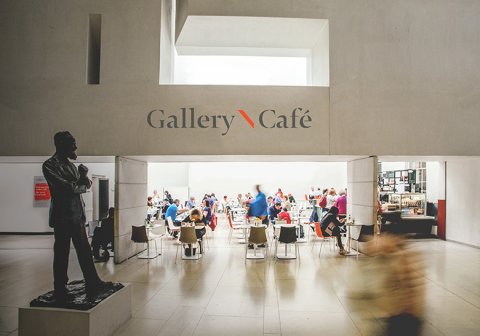
Entrance to the Mellenium Wing of the National Gallery and to Trinity College, Book of Kells
Visit Sweny bookshop and pharmacy, made famous by James Joyce in Ulysses or see the birthplace of famous Irish writer Oscar Wilde who was born on this street on October 16th 1854. An author, playwright and poet, Wilde was an extremely popular writer during Victorian times. Here you will see where he grew up as a child and a plaque in his memory. The east end of Trinity College Dublin runs along this street and you can link with Pearse Street Dart Station, or the Airlink Express 757 route from the city to Dublin Airport.
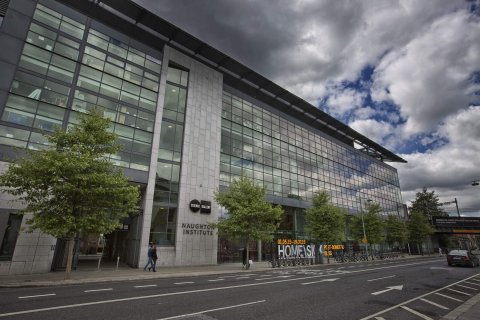
Get off opposite the Trinity City Hotel and take a walk down Pearse Street to the Science Gallery. Opened in 2008 in Trinity College Dublin the Science Gallery holds various lectures and exhibitions for all ages. Admission to the gallery is free. Open Monday 8.00am-5.00pm, Tuesday-Friday 12.00pm-8.00pm and Saturday/Sunday 12.00pm-6.00pm.
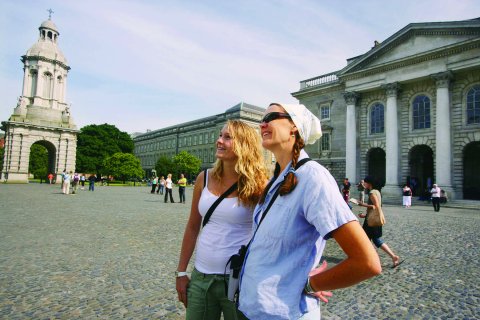
Hop off opposite the old Irish parliament buildings. Grattan Parliament housed Irish Members of Parliament up until 1800 when the Act of Union was passed and formally made Ireland and member of the United Kingdom which meant Irish politicians had to sit in parliament in London. Across from parliament you will see the main entrance to Trinity College Dublin. Visit the stunning Long Hall Library in the college where you’ll see the Book of Kells, a manuscript written by Irish monks in 800AD based on the four gospels of the new testament of the Bible. To book tickets and for further information visit their website.
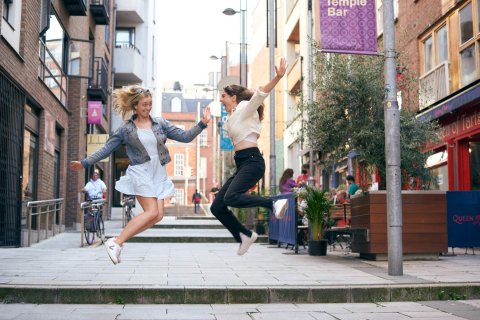
The Dame Street / College Green stop is only a short walk away from the famous Temple Bar. Get a taste of Dublin’s vibrant nightlife in this culturally enriched part of the city. With a great range of bars, restaurants, nightclubs and shops on offer why not drop down for a pint or bite to eat for what promises to be a day/evening full of craic.
Drop in to our friends at LazyBikeTours on Essex street or experience the Irish Rock N Roll Museum in Curved Street with a tour of a renowned venue and one of Ireland’s best loved rehearsal and recording complexes. Learn about the unheard stories of the musicians who pass through the halls. Start your own band and experience the feeling of being a real rockstar and discover exclusive memorabilia from the likes of U2, Thin Lizzy and many more.

Visit Dublin Castle and the fantastic Chester Beatty Library a hidden gem of Dublin situated within the grounds of Dublin Castle. With free admission and described by the Lonely Planet as not just the best museum in Dublin, but one of the best in Europe, the Chester Beatty Library is a must-see on any Dublin visitor's itinerary. For opening hours and what's on visit here
Cork Hill is the stop for one of Dublin’s most famous landmarks Dublin Castle. The castle has a very colourful history and its past functions vary from originally being built by King John of England in 1230 with the purpose of defending Dublin from invaders, the fortification was gradually modified over the centuries and eventually turned into a Georgian styled Palace. Nowadays it serves as a tourist attraction and for state functions, most notably the inauguration of the President of Ireland. Find out more here
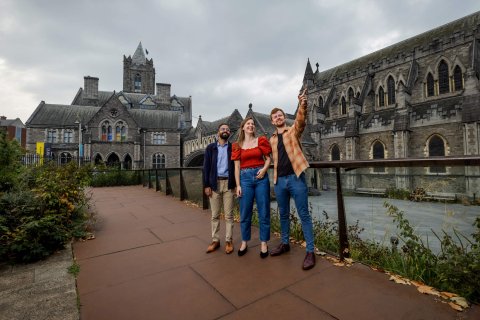
Christ Church Cathedral is a gothic/Romanesque style cathedral that was built in 1030 and was founded by the Hiberno – Norse King of Dublin. The cathedral is the official seat of the both Roman Catholic and Church of Ireland’s Archbishop of Dublin although the denomination of the church is officially Church of Ireland. The cathedral is located at Wood Quay the site of Viking Dublin and Dublinia, a Viking museum, is located in Synod Hall which is a part of Christ Church. For a fun day out have a look at their website.
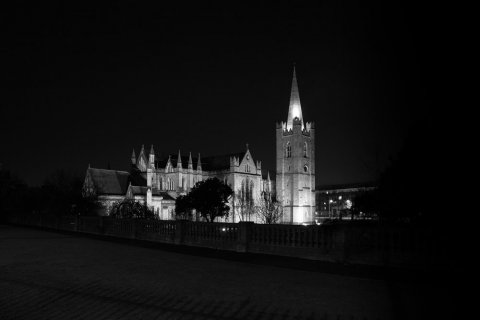
Completed in 1191 St. Patrick’s Cathedral is both Ireland’s tallest and largest church. First opened as a Catholic church after the English reformation the cathedral converted to Church of Ireland around 1537. The cathedral is now the national cathedral for the Church of Ireland with many notable deans buried in the floor and grounds such as Dublin born writer of Gulliver’s Travels Johnathan Swift. Right beside the Cathedral is St. Patrick's Park - a great place for a short stroll.

Taste some of Ireland’s finest whiskey at the Teeling Whiskey Distillery. It is the only operational distillery left in Dublin and the first of its kind to open its doors in over 125 years. For a day full of fun, facts and of course whiskey visit their website and plan your visit. Also a short walk from Stop 21 is The Liberties Distillery, where you'll learn a different take on the art of whiskey distilling, and also learn the story of the Liberties...the area of Dublin known as hell. Visit the Dublin Liberties Distillery website for more information and to book tickets.

The Guinness Storehouse is Ireland's most popular tourist attraction. St. James’s Gate Brewery was founded by Arthur Guinness in 1759. By 1886 it was the largest brewery in the world. With a 9,000 year lease, there’s plenty of time to have a pint of the black stuff at the Guinness Storehouse. Visit the famous 7th floor gravity bar where you can enjoy a pint of the black stuff and a 360 degree view of Dublin City. If heights aren’t your thing not to worry as Guinness offers a range of other bars, cafes and restaurants for you to enjoy.

Roe & Co opened its doors in 2019 as Dublin's newest and most exciting whiskey distillery, but it's heritage dates back to the 19th century when George Roe established Dublin's largest whiskey distillery on the site. As Ireland's largest whiskey exporter George Roe helped build a huge international interest in Irish whiskey that has endured until today. Over the last decade interest in Irish whiskey has grown exponentially resulting in the establishment of many new distilleries in Dublin city and especially in the Liberties area of the city. Roe & Co. is a big budget attraction which is owned by Guinness. It is aimed at whiskey lovers and offers fantastic tours and whiskey tastings. Definitely worth a visit! The distillery is open to adults only. Across the road from Guinness on James Street is another one of Dublin's newest attractions The Pearse Lyons Whiskey Distillery. Located in a former church, the distillery was lovingly constructed within, with no expense spared in restoring the original building. The result is a really worthwhile visitor attraction with a genuine experience learning about whiskey distilling and the story of St. James's and the Liberties. Visit the Pearse Lyons Distillery website for more information and to book tickets.
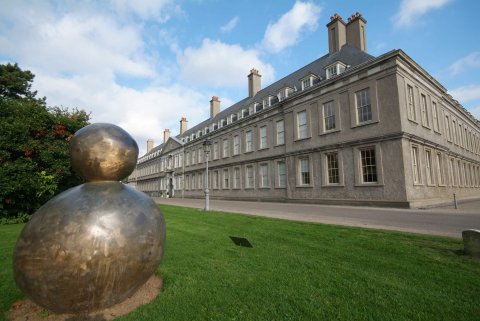
Irish Museum of Modern Art (IMMA). Dublin's third most visited attraction, The IMMA was formally opened in 1991 by then Taoiseach Charles J Haughey. IMMA is extremely popular among Dubliners who appreciate the fantastic quality of the exhibitions and events that are held at this venue. Visiting the gardens and seeing the stunning Georgian architecture will make the trip even more worthwhile. Visit the IMMA website here. Not to be missed!
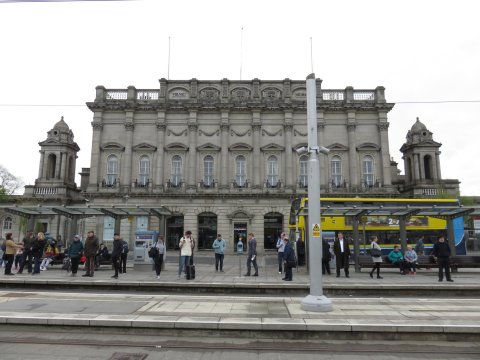
Heuston Station was opened in 1846 as Kingsbridge Station. Its name was changed in 1966, like several other train stations to Heuston Station to commemorate executed leader of the 1916 Easter Rising Sean Heuston who'd previously worked in the stations offices. Trains from here are operated by Iarnrod Éireann and serve both commuter and intercity routes such as Limerick, Cork and Galway. For more information on fares, tickets and routes click here
Phoenix Park was established in 1662 by Viceroy James Butler on behalf of King Charles II. The park is one of Europe’s larges at 707 hectares or 1752 acres. The park is also home to the residence of the president of Ireland, Áras an Uachtaráin which was completed in 1751 and has been the home of every Irish President since the first, Douglas Hyde in 1938. While in The Phoenix Park take a visit to Dublin Zoo one of the city’s most popular tourist attractions and what has been Ireland’s largest zoo since it was opened in 1831. Plan your visit here
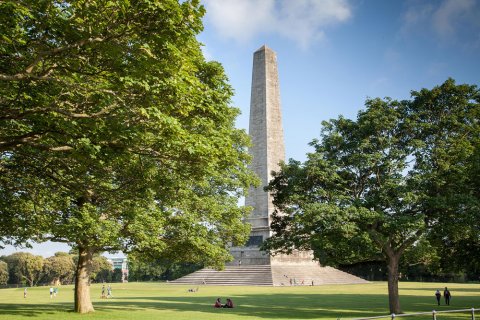
Take a walk up the quays and enjoy a peaceful stroll along the banks of the River Liffey. A great way to relax and enjoy the views of what Dublin has to offer on the banks of the river with some great photo opportunities along the away. Also see the wonderful piece of art that is the Anna Liva monument which personifies the River Liffey. The sculpture was completed in 1988 and originally placed on O’Connell Street but was moved in 2001 to make room for the spire. In 2011 the sculpture Anna Liva moved to Croppies Memorial Park where it currently sits today.
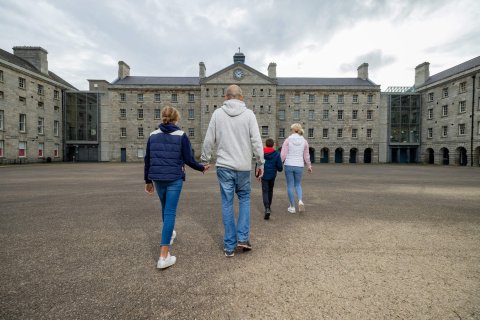
The National Museum of Ireland - Decorative Arts & History is part of the National Museum of Ireland and is therefore completely free to enter. A former army barracks, it is now home to The Decorative Arts and History section of the National Museum and also has dedicated military exhibitions. You can easily spend 2-3 hours just wandering around and looking at everything! Built in 1702 the barracks was initially called The Royal Barracks but its name changed after being given to the Free State after the War of Independence in 1922. The barracks was almost immediately renamed to Collins Barracks that year in memory of Michael Collins the commander in chief of the Free State army who was killed during the Civil War. The barracks’ military function ended in 1997 and today is home to The Decorative Arts and History section of the National Museum and also has dedicated military exhibitions. There is also a lovely cafe situated within the barracks.
Admission to the museum is free. It is open 7 days a week, but only opens 13:00-17:00 on Sunday and Monday, 10:00 - 17:00 the rest of the week. Plan your visit here

Jameson Whiskey Distillery is one of Dublin's top tourist attractions and it's easy to see why. The recently refurbished premises is beautifully laid and the tours provided are excellent. You will learn about the history of Jameson Whiskey and experience the sights and sounds of the entire distilling process with hands on demonstrations, and you'll also take part in whiskey tastings. At the end of the tour, enjoy a drink at the fantastic JJ's Bar.
This stop also serves St Michan's Church, while across the river is O'Shea's Merchant which is a very lovely pub serving excellent food and drink. O'Shea's also hosts live music and irish dancing events.
Also at this stop visit Smithfield Square where you can discover Cafés, Restaurants, Bars and Entertainment or drop in to watch a movie (and play some table-tennis) at the famous Lighthouse Cinema.
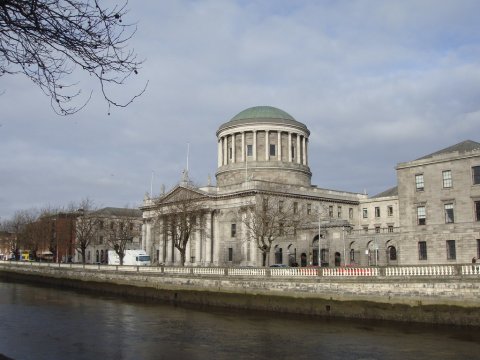
The Four Courts were opened in 1802 and today are home to the Supreme Court, The High Court and Dublin Circuit Criminal Courts. Designed by James Gandon (who also designed the Custom House) the Four Courts was the scene of fierce fighting in 1916 when it was taken over by Commandant Ned Daly. During the Civil War they were used as the headquarters of Anti-Treaty forces and this became the scene of fierce fighting between themselves and the Pro-Treaty National Army. The Four Courts is still in use today but only for civil matters, as the criminal courts have moved up to a new building The Criminal Courts of Justice, beside the Phoenix Park.
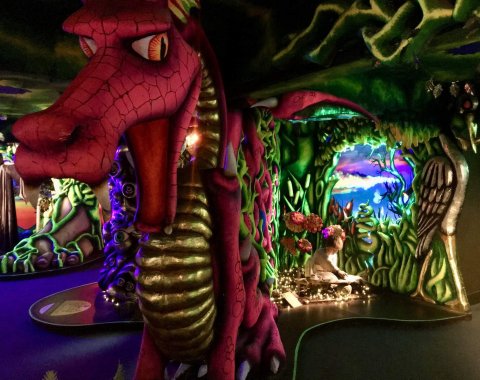
The Wax Museum Plus has recently re-located to Westmoreland Street, just across the river from the tour stop at Bachelors Walk. Their fantastic new venue provides room for many more exhibits and loads of interesting things to see for all ages. Visit the new Children's Fantasy Wax World, go back in time in the Time Vaults, learn the Great Irish writers and see what they looked like in the flesh (well nearly), See Ireland's favourites like Father Ted and Conor McGregor and of course visit the dreaded Chamber of Horrors. They can cater for groups of any size, and have always been a favourite attraction for Dublin children. Visit the WaxMuseumPlus website for more information
Also visit Dublin's most famous landmark the Ha'penny bridge. Opened in 1816 the pedestrianised bridge is extremely popular with those visiting Dublin. The name of the bridge comes from the toll that had to be paid (1/2 a penny) for crossing the bridge when it was originally opened to pay for its construction. This is the last stop on the tour. Note; the bus will continue back to O'Connell Street where you will be required to exit and join the next tour leaving from Stop 1.